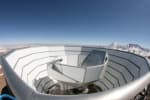Despite making up roughly 85% of all matter in the universe, the fundamental nature of dark matter (DM) still eludes scientists. Very little is known about it because it does not interact with light and is observed mainly via gravitational interactions. A possible candidate for dark matter are theoretical particles called weakly interacting massive particles […]
Research
IceCube search for a correlation between galaxies and neutrinos
The IceCube Neutrino Observatory, embedded in a cubic kilometer of Antarctic ice, searches for weakly interacting particles called neutrinos that are able to travel undisturbed through the cosmos. Of interest are high-energy astrophysical neutrinos that can arise from cosmic ray interactions with matter or photons in astrophysical sources. So far, high-energy neutrino emission has been […]
Search for dark matter from the center of the Milky Way
Despite making up roughly 85% of all matter in the universe, the fundamental nature of dark matter (DM) still eludes scientists. Thus far, no experiment has been able to determine what dark matter is made of. One way scientists are probing for DM is by looking at the production of ordinary particles when two DM […]
Evidence for neutrino emission from X-ray-emitting galaxies
In 2022, the IceCube Neutrino Observatory at the South Pole announced evidence for high-energy neutrinos spewing from the “nearby” active galaxy NGC 1068. One of the brightest X-ray sources in the universe, NGC 1068 is an active galactic nucleus (AGN) with a central, supermassive black hole that actively gobbles up surrounding matter. X-rays shine brightly […]
Quantifying the estimated sensitivity of the IceCube Upgrade to atmospheric neutrino oscillations
As cosmic rays collide with particles in the Earth’s atmosphere, air showers containing atmospheric muons and neutrinos are produced. The atmospheric neutrinos are then detected by DeepCore, a denser and smaller array of sensors in the center of the IceCube Neutrino Observatory at the South Pole. Compared to the main IceCube detector, DeepCore is sensitive […]
Observation of a spectral change in the flux of astrophysical neutrinos
The IceCube Neutrino Observatory, embedded in a cubic kilometer of Antarctic ice, searches for weakly interacting particles called neutrinos that are able to travel undisturbed through the cosmos. Of interest are high-energy astrophysical neutrinos that can arise from cosmic ray interactions with matter or photons in astrophysical sources. Thus far, the dominant sources of the […]
Identifying and cleaning radio signals from cosmic-ray air showers using machine learning
When high-energy particles called cosmic rays collide with Earth’s atmosphere, they create cascades of particles or air showers that emit faint radio signals. Because they are so faint, they are often drowned out by background signals from natural sources (the universe) and man-made sources (radio transmitters), making it difficult to discern signals originating from a […]
Successful design, production, and testing of LED calibration systems for Upgrade sensor modules
Neutrinos are weakly interacting particles that are able to travel unhindered through the cosmos. When a neutrino interacts with a molecule in the ice, blue light is emitted from the resulting secondary charged particles through a process called Cherenkov radiation. The IceCube Neutrino Observatory at the South Pole consists of an array of 5,160 optical […]
GollumFit: An open-source software for neutrino telescope analyses
At the South Pole, there exists the IceCube Neutrino Observatory, a gigaton-scale detector that detects tiny, nearly massless particles called neutrinos. Neutrinos can travel unhindered through space and, thus, can help uncover otherwise obscured parts of the universe. Many IceCube analyses study a diffuse neutrino flux—coming from all directions across the entire sky—that originate mostly […]
A search for a correlation between millimeter-bright blazars and astrophysical neutrinos
Blazars are active galactic nuclei (AGN)—supermassive black holes at the centers of galaxies—that shoot out powerful jets of particles and light directed at Earth, making them some of the brightest objects in the universe. Because blazars can accelerate particles to extremely high energies, they are an attractive candidate as sources for high-energy neutrinos, the subject […]









